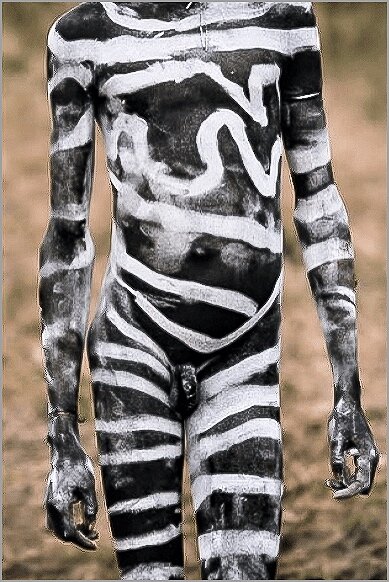“Hans Silvester Omo Valley Ethiopia Tribal Body Painting”
The Art of Fine Art Photography Blog
“Hans Silvester - Omo Valley, Ethiopia, Tribal Body Painting”
The Indigenous Human Canvas
In the early 2000s German photographer Hans Sylvester made a dozen trips shooting in the remote regions of the Omo Valley in Ethiopia. His imagery celebrates the diversity of the tribal cultures there as represented by this collection of photos depicting the innate artistic body painting talents of the nomadic tribes that populate this region.
Note: Images featured in this blog post were photographed by
Copyright © Hans Silvester.
Where indicated fine art prints are available for online purchase.
The fine art of indigenous body painting flourishes in this African cradle of humanity and was perfected centuries ago by the Surma and Mursi tribespeople in the region whose bodies become walking masterpieces of artistic display. They are agro-pastoralists whose color palette derives from the land.
In a tradition that has remained unchanged for millenia, they use natural pigments and sacred, pulverized minerals found in this volcanic region: white limestone, red ochre, copper green, luminous sulphuric yellow, or drab ash grey. Their designs are accentuated with flowers, leaves, grasses, berries, or seed pods and often with shells, butterfly wings, animal skins, or horns, or teeth, or tails plus the odd modern accouterment—glass beads, bottle caps or bullet casings.
Over the decades the region has endured incessant tribal and guerilla warfare and has been a hotbed for illicit arms and ivory trading. But during periods when the Kalashnikovs fall silent, the area reverts back to a more tranquil ambiance when the tribespoeple resume their traditional body painting and daily life routines.
Being nomadic peoples, they have not encumbered themselves with possessions, which are limited to what they can carry on their backs or shoulders and generally include a few gourds, clay pots, animal skins and their weapons—knives for the women and children, Kalashnikovs for the men.
Eyes are windows into the soul.
In the past, there were no mirrors. Even today the villagers take turns painting each other’s bodies with seemingly spontaneous outbursts of wild design fantasy using circles and lines and dots and amorphous patterns at whim’s delight yet with measured control and restraint. Their artistic strokes are ruled by an innate grasp of organic form and shape and balance and are executed with a freedom that reveals intrinsic creative skills inspired by rituals and gods and each other. Even young kids possess such talent.
Tribal Body Painting Nudity
There is no inhibition in the Omo Valley. Nudity is natural.
Art reigns supreme.
They paint faces and arms and legs, buttocks and breasts and genitalia. All is a canvas to explore artistic design. It’s a glorious display of zest for life, an expression of joy and pride. Of course, slathering ones body with clay pigments has a practical implication—sunburn is minimized. And limestone functions as a natural insecticide preventing bug bites on an otherwise nakedly exposed torso.
But, more importantly, these tribes use their designs and colors to designate social position, to ward off illness, for ritual, for courtship, to associate oneself with family or tribe or an animal . . . and more recently to attract tourists with big cameras and big tips. Nevertheless, their facial expressions often seem to indicate wariness of a culture at great risk by such blatant intrusion.
Decorative scarification is common for teens and young adults to augment beauty while also functioning as a visual display of bravery in having endured much pain. Blood and torturous ordeal prepares youth for inevitable battles with warring tribes.
Design serves function.
Youngsters are painted white with clay to ward off supernatural evil forces.
Their bodies become an expressive palette to perpetuate their instinctive artistic talents.
Perhaps we in the West should utter fewer complaints laced in negativity and instead just wear flowers in our mouths.
Smell the roses. Celebrate diversity.
Most tribes of the Omo Valley don’t practice a specific religion but they do profess living life in harmony with nature and with the spirit world. They regard illness as a separate bodily process stemming from a fundamental disturbance in the harmonious relationship between people and their social or natural environments.
Why is it “modern” Western societies have such difficulty grasping such easily discerned truths?
: :
Follow Hans Silvester’s Fan Page on Facebook.
See a slide show of one hundred tribal photographs by Hans Sylvester.
•
Glen Allison
See my “Untamed - Tribal Wild” blog post featuring body-painted models I photographed in my Bangkok studio using brush strokes inspired by those found in the Omo Valley.
Explore the new world of digital art in this blog post.
Follow Me 0n Social Media
Share this page with your friends.
“THE ART OF FINE ART” Blog
THE ART OF FINE ART
Blog
Recent
BLOG POSTS
↓
| Back To Top |





















































